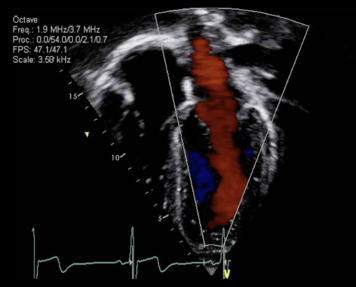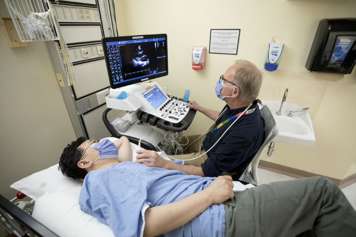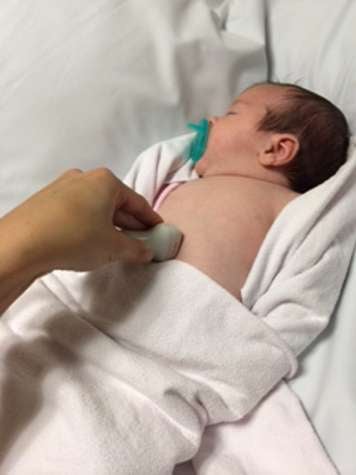What is an echocardiogram?

An echocardiogram (or 'echo' for short) is an ultrasound test of the heart which uses a special ultrasound camera placed on top of the skin and emits sound waves into the body. These sound waves meet structures in the body and reflect (or echo) back to the camera, allowing the health-care team to visualize and assess your child’s heart.
Preparing before the echocardiogram
Most children do not need to do anything special to get ready for an echocardiogram. However, if your child is under three years old or cannot lie still, they may need a sedative. A sedative is a medicine that will help your child sleep for the test. An echocardiogram works best when the child does not move.
Without a sedative
If your child does not need a sedative, they can eat and drink normally before and after the echo. If your child has a comforting toy or a security blanket, please bring that along. There is a television in each echo exam room that your child may watch to pass the time.
Very young babies cannot be given a sedative. This includes babies who are premature or very small. If this is the case for your child, ask the doctor or nurse what the options are.
If your child needs a sedative for the echocardiogram
Your child needs to lie still during the test so the test results will be accurate. If your child needs a sedative, the bedside nurse will give your child medicine to swallow. This is medicine that will help your child sleep for the test. The medicine lasts just long enough for the test to be done. The nurse will monitor your child throughout the sedation process.
For sedation, your child must stop eating and drinking several hours before the test. A nurse will call you in the week before the test to make sure you understand the process. The table below describes what and when your child can eat and drink.
| Time before test | What you need to know |
|---|---|
| 8 hours | No more solid food, milk or orange juice. This also means no gum or candy. Your child can still drink clear liquids. Clear liquids are anything you can see through, such as apple juice, ginger ale or water. Your child can also eat Jell-O or popsicles. |
| 6 hours | No more milk or formula. |
| 4 hours | Stop breastfeeding your baby. |
| 2 hours | No more clear liquids. This means no more apple juice, ginger ale or water. Your child cannot eat any Jell-O or popsicles. |
For more information about sedatives, please visit the sedation page or ask your doctor or nurse.
General anaesthesia for echocardiograms
If your child is older than three years but cannot lie still, they may need general anaesthesia. Your child will have an appointment in another area of the hospital and there will be an anesthesiologist (sleep doctor) who provides the medication and monitors your child during the procedure. The echo machine will be brought to your child. A nurse will call you the week before the test to make sure you understand how to get ready for the test and the sleep medicine.
Role playing the test with your child
You and your child can practice the test at home.
Have your child lie on their back on a bed with the lights dimmed. Tell them that it will be warm and very quiet because the sonographer must concentrate on the study. Tell them the sonographer will put three small stickers on their chest. Put some warm hand lotion on the middle and left side of your child's chest. With the bottom of a smooth drinking glass push the hand lotion around on the chest. Explain that the glass is like the camera that the sonographer uses to take the pictures. Bring along your child's special toy or security blanket. Tell your child they will have to remove their shirt or sweater and wear clothing provided at the echo lab. Tell your child that you may lie down beside them on the echo bed during the test if they wished. Make sure the child knows the test will take some time, but you will never leave them alone.
Helping your child prepare for the echocardiogram
Be honest and open with your child about what to expect. Explain what will happen during the echocardiogram. Use as much detail as you think is appropriate for your child's level of understanding. Tell them about the appointment in advance so they are not surprised to show up at the hospital. Let your child know that you will be with them during the test.
The video below can be used to help prepare your child for an echocardiogram, a vascular ultrasound or a bicycle stress echo.
What will happen during the echocardiogram

The person who will do the test is specially trained to perform echocardiograms. This person is called a cardiac sonographer.
The sonographer will first measure your child's weight and height. Then, they will bring you and your child to an echo test room.
Your child will change from their sweater, shirt and other clothes above the waist and into a gown provided by the sonographer. There are private areas in the echo room to change.
Your child will lie on a special bed that can move up and down. The sonographer will put three stickers on your child's chest or arms. These stickers are called electrodes. They are connected by wires to the echo machine. They record your child's heartbeat during the test.
Next, the sonographer will put some warmed ultrasound jelly on your child's chest and belly so that the ultrasound camera can move easily over your child's skin. The sonographer will take pictures of your child's heart from different angles. Your child may feel some gentle pressure from the camera position and movement. Pictures are taken from the stomach, over the chest and from the neck. Your child may also be asked to lie in different positions throughout the test: on their back, on their side, on their back with their head tilted up. At times, your child may hear a loud swooshing noise when the echo machine records the flow of the blood through the heart.

The lights in the room will be dimmed so the sonographer can see the pictures on the computer screen.
After the sonographer completes the pictures, they will make a report and show the images to one of the cardiologists, a heart specialist. The cardiologist may choose to take more pictures at this time. This is a normal part of the test. During this time, your child will stay connected to the echo machine. The sonographer or nurse will let you know when your child can get dressed again.
An echocardiogram takes from 30 minutes to 90 minutes or more. Often the first echocardiogram that your child has will take longer. How long the test lasts will also depend on why your child's doctor asked for the test.
Other kinds of echocardiograms
What is a fetal echocardiogram?
When an echocardiogram is done when the baby is still in the mother’s womb, it is called a fetal echocardiogram. This echo can detect malformations as early as 16 weeks into the pregnancy, when the parts of the baby’s heart become clearly visible. It is usually done if there is a family history of congenital heart disease, if chromosomal or other abnormalities are suspected, if the heartbeat is irregular, or if the mother has medical problems that might affect the development of the heart.
To have this test, the mother will have her stomach covered in ultrasound jelly to help transmit the sound waves and get good quality pictures. For this test, it is usually not necessary to drink water before the appointment.
For more information, please visit the Fetal Cardiac Program website.
What is an exercise stress echocardiogram?
This echocardiogram is performed while your child is cycling on a special bicycle. Images of the heart are acquired before your child starts pedaling on the bicycle, while they are pedaling and again after the exercise. Your child’s blood pressure and the heart’s electrical activities are also monitored throughout the test.
This test is performed to study how the heart muscle contracts and how the blood flows through the heart valves and coronary arteries when not in resting condition. This test is often done to explore the effect of exercise on the heart, and how fast the heart recovers from exercise.
What is a dobutamine stress echocardiogram?
The dobutamine stress echo is a form of stress echocardiography performed with the use of a drug named dobutamine administered via IV, with or without sedation. Dobutamine is a drug that makes the heart beat faster, similarly to what exercise does. Dobutamine does not stay long in the body and has no lasting effects. Without sedation, children may feel anxious during the test because they may feel their heart beating faster, like when they are exercising, also there might be an increase in perceived temperature. This test is performed for similar reasons as the exercise stress echocardiogram but used for children who are unable to perform the exercise test.
What is a bubble study?
When indicated, a fluid called contrast medium is injected into your child’s bloodstream during the echocardiogram. This helps give a better picture of your child’s heart on the echocardiogram. One type of contrast medium is saline (sterile salt water) mixed with a gas. Usually, the gas is carbon dioxide, the same gas that makes soda fizzy. When this solution is used, it is called a bubble study.
A bubble study lets the cardiologist follow the path that the bubbles take through the bloodstream. This helps to find heart or lung problems. The bubble study is safe and the bubble solution is easily absorbed into your child’s bloodstream.
What is a transesophageal echocardiogram (TEE)?
A transesophageal echocardiogram (TEE) is an echocardiogram carried out by putting a special probe down the throat. The probe is a thin flexible tube with a miniature camera on the end. The child is given a general anesthetic during the procedure.
A transesophageal echo takes clearer pictures than a regular echo since it can get closer to the heart. A TEE is done if the pictures from the normal echo are not good enough, at the end of surgery, in the operating room, and sometimes during heart catheterization.
Getting the results of the echocardiogram
Your child’s cardiologist, doctor, or other specialist who ordered the test are the only people who can give you the results of your child’s echocardiogram.
The sonographer doing the test, or the cardiologist reviewing the pictures is not allowed to give you the results. This is important because they may not be aware of all of your and your child’s health concerns.
At SickKids
This test is usually performed in the Echocardiography Laboratory (Echo Lab), part of the Labatt Family Heart Centre, located on 4B in the Atrium of the hospital. Sedated echocardiograms are usually performed in the Cardiac Catheterization Lab in the Burton Wing. We also perform bedside echocardiograms for patients throughout the hospital.
Within the Echo Lab, we also operate the Fetal Cardiac Program as well as our research lab. For more information about our research or if you or someone you know would be interested to participate in cardiovascular research, please visit us at the Cardiovascular Ultrasound Research Lab website.